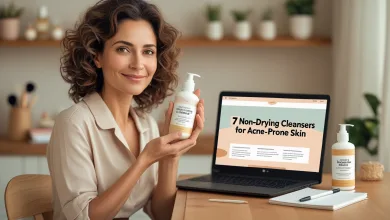Why Your Hormones Cause Acne and What You Can Do About It

Hormonal acne isn’t just a teenage problem. From stress to diet, numerous factors influence your hormone levels and can trigger those frustrating breakouts. Here’s your comprehensive guide to understanding the hormonal causes of acne and the most effective solutions for long-term clear skin.
The Hormonal Acne Connection: Why Your Skin Erupts
Ah, hormones—those chemical messengers that seem to have a mind of their own. When they’re balanced, everything’s peachy. But when they go haywire? Hello, unwanted breakouts! If you’ve ever wondered why your skin erupts like clockwork around your period or during particularly stressful weeks, you’re witnessing the powerful connection between your hormones and your skin.
Hormonal acne differs from regular acne in both its underlying causes and typical appearance. While regular acne can strike anywhere and often results from clogged pores, hormonal acne tends to cluster around the lower face—particularly the jawline, chin, and neck. It’s also typically deeper, more painful, and more stubborn than your garden-variety pimple. What’s more, hormonal acne doesn’t just affect teenagers; it can ambush adults well into their 40s and beyond, making it a frustrating companion for many throughout their lives.
Androgens: The Primary Culprits Behind Your Breakouts
When it comes to hormonal acne, androgens (like testosterone) are often the main troublemakers. These hormones stimulate your skin’s oil glands to produce excess sebum—that sticky, waxy substance that can clog pores and create the perfect breeding ground for acne-causing bacteria. While we typically associate testosterone with men, women produce it too, albeit in smaller amounts.
During certain times of your menstrual cycle, androgen levels rise, triggering that all-too-familiar pre-period breakout. Similarly, conditions like polycystic ovary syndrome (PCOS) can cause chronically elevated androgen levels, leading to persistent acne that seems impossible to kick. According to a 2020 study published in the Journal of Clinical Endocrinology & Metabolism, up to 80% of women with PCOS experience acne as a symptom of their condition, highlighting just how powerful these hormonal influences can be.
The Hormone Rollercoaster: Life Stages That Trigger Acne
Hormonal fluctuations are an inevitable part of life, and unfortunately, many of these natural transitions can wreak havoc on your skin. Let’s break down the key life stages when hormonal acne tends to make an unwelcome appearance:
Puberty and Adolescence
During puberty, hormone production kicks into high gear. The surge in androgens stimulates sebaceous glands, causing them to enlarge and produce more oil than your skin can effectively manage. This explains why up to 85% of teens experience acne to some degree, according to the American Academy of Dermatology.
For teenagers experiencing acne, it’s not just a cosmetic issue—it can have significant psychological impacts during a vulnerable developmental stage. Research has linked adolescent acne to increased rates of depression, anxiety, and social withdrawal, emphasizing the importance of addressing the condition compassionately and effectively.
Menstrual Cycles
For many women, breakouts are as reliable a period tracker as any app on your phone. The week before menstruation, estrogen and progesterone levels drop while androgen levels remain relatively stable. This hormonal shift creates the perfect storm for acne development.
Dr. Rachel Reynolds, a dermatologist at Harvard-affiliated Beth Israel Deaconess Medical Center, explains: “About 60-70% of women notice their acne worsening the week before their period. This premenstrual flare is so common that it’s considered a normal variant of acne”.
Pregnancy
Pregnancy brings a tsunami of hormonal changes, with some women experiencing the much-touted “pregnancy glow” while others face unprecedented breakouts. During the first trimester especially, the body produces increased amounts of progesterone, which can stimulate oil production and trigger acne.
Interestingly, many women who struggled with acne before pregnancy find that their skin clears up during the later stages as estrogen levels rise and remain high. However, the postpartum crash in estrogen can lead to another wave of breakouts after delivery.
Perimenopause and Menopause
Just when you thought you might be free from acne concerns, perimenopause enters the chat. As women approach menopause, estrogen levels begin to decline while androgen levels remain relatively stable, creating a relative androgen dominance that can trigger adult-onset acne.
Dr. Mary Jane Minkin, a clinical professor of obstetrics, gynecology, and reproductive sciences at Yale School of Medicine, notes that “About 25% of women in their 40s and 15% of women in their 50s experience acne flares related to hormonal fluctuations of perimenopause”.
Stress and Your Skin: The Undeniable Connection
Ever noticed a massive pimple appearing right before an important presentation or first date? That’s not just bad luck—it’s your stress hormones at work. When you’re stressed, your body produces more cortisol, which can increase oil production and inflammation, creating the perfect environment for acne to flourish.
Beyond just increasing oil production, chronic stress can disrupt your entire hormonal ecosystem. It triggers what scientists call the HPA axis (hypothalamic-pituitary-adrenal axis), essentially putting your body in a state of constant fight-or-flight response. This not only increases cortisol but can also stimulate the release of other hormones that exacerbate acne.
A ground-breaking 2003 study published in the Archives of Dermatology found a direct correlation between stress levels and acne severity in students. During exam periods, when stress levels peaked, acne worsened significantly compared to less stressful times of the semester. Talk about adding insult to injury!
Diet, Hormones, and Your Skin: What Research Reveals
What you put on your plate might be showing up on your face. Mounting evidence suggests that certain dietary patterns can influence hormone levels and potentially trigger acne breakouts. Here’s what the science says:
High-Glycemic Foods and Insulin Resistance
Foods that cause rapid spikes in blood sugar—like white bread, sugary cereals, and processed snacks—trigger insulin production. Elevated insulin levels can increase androgen production and decrease sex hormone-binding globulin (SHBG), a protein that normally binds to androgens to keep them in check.
A landmark 2007 study published in the American Journal of Clinical Nutrition found that participants following a low-glycemic diet showed significant improvements in their acne compared to those eating a high-glycemic diet. This research has been supported by numerous subsequent studies, establishing a compelling link between blood sugar stability and skin health.
Dairy Products and Hormonal Influence
Got milk? You might also have acne. Dairy products—particularly skim milk—have been linked to acne in multiple observational studies. One theory is that the hormones naturally present in milk (even organic varieties) can influence our own hormonal balance.
A 2018 meta-analysis published in the journal Nutrients examined data from 14 studies involving nearly 80,000 participants and found a positive association between dairy consumption and acne. While correlation doesn’t prove causation, the evidence is strong enough that many dermatologists now recommend a trial period of dairy elimination for patients struggling with persistent acne.
Natural Ways to Balance Hormones and Clear Your Skin
Now for the good stuff—practical strategies to balance your hormones naturally and kiss those breakouts goodbye! While hormonal acne can be stubborn, these evidence-based approaches have helped countless people achieve clearer skin without harsh medications:
Dietary Modifications
Your fork can be a powerful tool in your anti-acne arsenal. Consider these dietary adjustments:
- Adopt a low-glycemic diet: Focus on whole foods like vegetables, legumes, and unprocessed grains that don’t cause dramatic blood sugar spikes.
- Limit dairy consumption: Try plant-based alternatives to milk, yogurt, and cheese to see if your skin improves.
- Increase omega-3 fatty acids: Found in fatty fish, walnuts, and flaxseeds, these healthy fats have anti-inflammatory properties that may help calm acne.
- Boost zinc-rich foods: Oysters, pumpkin seeds, and legumes are excellent sources of this mineral, which research suggests may help reduce acne severity.
- Stay hydrated: Drinking adequate water helps flush toxins and supports overall hormone balance.
Stress Management Techniques
Since stress hormones can trigger or worsen acne, finding effective ways to manage stress is crucial for clear skin:
- Mindfulness meditation: Even just 10 minutes daily can significantly reduce cortisol levels. Apps like Headspace and Calm offer guided sessions specifically for stress reduction.
- Regular exercise: Physical activity releases endorphins, nature’s stress fighters. Aim for at least 30 minutes of moderate exercise most days of the week.
- Adequate sleep: Poor sleep increases cortisol and throws other hormones out of whack. Prioritize 7-9 hours of quality sleep each night.
- Breathwork: Simple breathing exercises like box breathing (inhale for 4, hold for 4, exhale for 4, hold for 4) can activate your parasympathetic nervous system and lower stress hormones in real-time.
Supplements with Scientific Support
Certain supplements may help balance hormones and improve skin health:
- Spearmint tea: Research suggests that drinking spearmint tea twice daily may reduce androgen levels in women with PCOS and improve associated acne.
- Vitamin D: Many people with hormonal acne show low vitamin D levels. Supplementation may help improve both hormone balance and skin health.
- DIM (Diindolylmethane): This compound, found in cruciferous vegetables, may help the body metabolize estrogen more efficiently.
- Zinc: Studies show that people with acne often have lower zinc levels, and supplementation can reduce acne severity in some cases.
- Omega-3 supplements: If you don’t regularly eat fatty fish, fish oil supplements may help reduce inflammation associated with acne.
Remember to consult with a healthcare provider before starting any new supplement regimen, especially if you’re taking medications or have underlying health conditions.
Medical Treatments for Hormonal Acne: When to Consider Professional Help
While natural approaches work for many people, sometimes hormonal acne requires medical intervention. Here’s when to consider seeking professional help and what treatments might be recommended:
Topical Treatments
Dermatologists often start with topical treatments that can help manage hormonal acne:
- Retinoids: These vitamin A derivatives help prevent follicular plugging and reduce inflammation. Prescription-strength options like tretinoin or adapalene are particularly effective for hormonal acne.
- Benzoyl peroxide: This ingredient kills acne-causing bacteria and helps reduce inflammation. It works well in combination with other treatments.
- Azelaic acid: Often overlooked but highly effective, azelaic acid reduces inflammation and kills bacteria while also helping with the post-acne hyperpigmentation that often accompanies hormonal breakouts.
Oral Medications
For more persistent or severe hormonal acne, oral medications may be necessary:
- Birth control pills: Certain FDA-approved oral contraceptives can help regulate hormones and improve acne. They work by increasing sex hormone-binding globulin, which reduces free testosterone in the bloodstream.
- Spironolactone: Though technically a blood pressure medication, spironolactone blocks androgen receptors and decreases testosterone production, making it highly effective for hormonal acne in women.
- Isotretinoin: Previously known as Accutane, this powerful vitamin A derivative is typically reserved for severe, cystic acne that hasn’t responded to other treatments. It requires close monitoring due to potential side effects.
According to Dr. Emmy Graber, president of the Dermatology Institute of Boston, “For women with hormonal acne, a combination approach often works best. I typically recommend a topical retinoid along with either spironolactone or a birth control pill, depending on the patient’s needs and preferences”.
Skincare Strategies for Hormonal Acne
While addressing the root hormonal causes of acne is essential, your skincare routine can either help or hinder your progress. Here’s how to optimize your regimen for hormonal breakouts:
Gentle Cleansing
Contrary to popular belief, harsh scrubbing won’t clear hormonal acne—it might actually make it worse by irritating the skin and triggering more oil production. Opt for gentle, pH-balanced cleansers that remove excess oil without stripping the skin.
Dr. Whitney Bowe, a board-certified dermatologist and author of “The Beauty of Dirty Skin,” recommends cleansing no more than twice daily: “Over-cleansing disrupts your skin’s natural barrier and microbiome, which can exacerbate hormonal acne rather than helping it”.
Strategic Ingredients
Look for skincare products containing these acne-fighting ingredients:
- Salicylic acid: This beta-hydroxy acid penetrates oil glands to unclog pores and reduce inflammation.
- Niacinamide: A form of vitamin B3 that helps regulate oil production and strengthen the skin barrier.
- Green tea extract: Contains EGCG, which research suggests may help reduce sebum production and inflammation.
- Bakuchiol: A plant-derived alternative to retinol that helps cell turnover without as much irritation.
Moisturizing (Yes, Even for Acne-Prone Skin!)
Many people with acne skip moisturizer, fearing it will make their skin oilier. In reality, properly hydrated skin produces less excess oil. Choose non-comedogenic moisturizers labeled “oil-free” or specifically formulated for acne-prone skin.
Adjusting Your Routine to Your Cycle
For those with menstrual cycles, consider cyclical skincare—adjusting your routine based on hormonal fluctuations:
- Week before period: When oil production increases, incorporate more oil-controlling ingredients like salicylic acid and clay masks.
- During menstruation: Focus on soothing inflammation with ingredients like centella asiatica and aloe vera.
- Post-period: Address post-acne marks with ingredients that fade hyperpigmentation, like vitamin C and alpha arbutin.
FAQs About Hormonal Acne
Q: How can I tell if my acne is hormonal or caused by something else?
A: Hormonal acne typically appears on the lower face (chin, jawline, and neck), tends to flare up at consistent times of the month or during periods of stress, and often manifests as deep, painful cysts rather than surface-level whiteheads or blackheads. If your breakouts follow this pattern, hormones are likely playing a significant role.
Q: Can men get hormonal acne too?
A: Absolutely! While we often associate hormonal acne with women’s menstrual cycles, men can definitely experience acne related to hormonal fluctuations. Men generally have higher baseline levels of androgens like testosterone, which can stimulate oil production and lead to acne. Stress, certain medications, and medical conditions can all influence hormone levels in men and trigger breakouts.
Q: How long does it take to see results when treating hormonal acne naturally?
A: Patience is key when addressing hormonal acne naturally. Dietary changes typically take about 4-6 weeks to show noticeable improvement, as this is how long your skin’s renewal cycle takes. Stress reduction techniques may show benefits sooner, but establishing new habits takes time. Most experts recommend giving any natural treatment at least 3 months of consistent use before evaluating its effectiveness.
Q: Will my hormonal acne ever go away completely?
A: Many people find that with the right combination of lifestyle modifications and treatments, their hormonal acne can be effectively managed or even eliminated. However, since hormonal fluctuations are a natural part of life, some people may experience occasional flare-ups during times of stress, hormonal transitions, or when they stray from their maintenance routine. The good news is that with consistent care, these flare-ups typically become less severe and more manageable over time.
Q: Is it true that certain foods can trigger hormonal acne?
A: Research increasingly supports the connection between diet and hormonal acne. High-glycemic foods (like white bread, sugary cereals, and processed snacks) can spike insulin levels, which may increase androgen production and oil secretion. Similarly, dairy products contain naturally occurring hormones that can potentially influence our own hormonal balance. However, food triggers can be highly individual—what causes breakouts for one person might not affect another.
The Final Word: Taking Control of Your Hormones and Your Skin
Living with hormonal acne can be frustrating, but understanding the connection between your hormones and your skin is the first step toward finding effective solutions. By addressing the root causes—whether through dietary changes, stress management, targeted skincare, or medical treatments—you can achieve clearer, healthier skin.
Remember that hormonal balance is a dynamic process, not a destination. Our bodies continually adjust to internal and external factors, so what works today might need tweaking tomorrow. Be patient with yourself and your skin as you navigate this journey, and don’t hesitate to seek professional guidance when needed.
The good news? With the right approach, hormonal acne doesn’t have to be a permanent part of your life. By implementing the strategies outlined in this article and working with healthcare providers when necessary, you can take control of your hormones and enjoy the clear skin you deserve.






